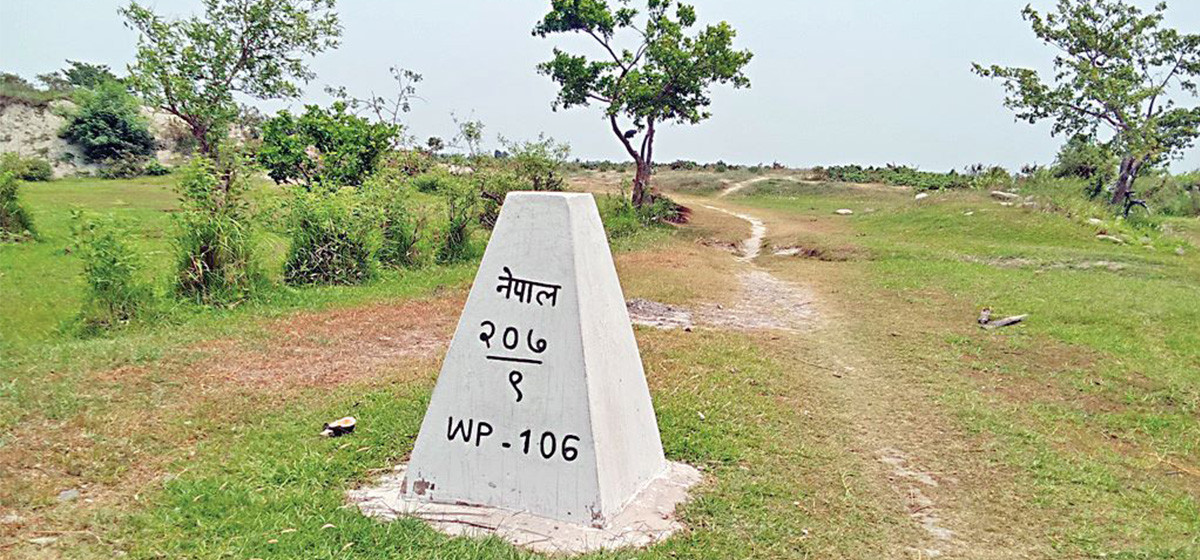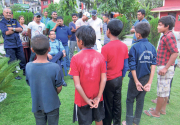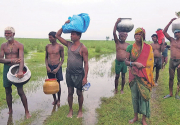
OR
India encroaches upon Nepali territory near Koshi Barrage in Sunsari
May 11, 2024 09:00 AM

ITAHARI, May 10: The Saptakoshi River recently altered its course to the southeast of the Koshi barrage, causing a boundary marker to ‘vanish’. Locals from Koshi Rural Municipality-8 in Sunsari claim that the true Nepal-India border should align with the river's current position, which is 300 meters south of the existing border post. However, they allege that pillar number 207/9 is positioned incorrectly, situated slightly north of its rightful place, encroaching upon Nepali territory.
Following the ‘disappearance’ of a border pillar allegedly washed away by the Saptakoshi River, locals reported erosion of land on the Nepal side. Ganesh Tamang, a resident of Koshi-8 living east of the Koshi barrage for 30 years, said, “The government should seriously study this again.” According to him, after the Koshi River altered its course in 2014 and swept away the boundary pillar, it was relocated northward, leading to the establishment of a new boundary.
The Nepal-India border is not a straight line anywhere but it is more twisted in Koshi Rural Municipality, Sunsari. Pillar number 206/6 stands merely 30 meters away from the East-West Highway at the border checkpoint in Koshi Rural Municipality-8, near Bhimnagar, India. A longtime resident of the area, 95 years old Jetha Lama, said, "The border between Nepal and India is very curved. I have been living here since my father's time." He said that there are generally no issues along the Nepal-India border, but there are suspicions that the last pillar (207/9) towards the west of Sunsari might have been tampered with or moved.
The Armed Police Force unit which guards Nepal’s international borders in Sunsari reported discrepancies regarding the area's border pillars. Although records indicate there are 23 border pillars in Sunsari, these pillars are not visible in the field. The missing structures include 19 auxiliary and four main pillars. According to the Armed Police Force records, 11 new border posts were constructed in Sunsari in the fiscal year 2074/75 BS, and four were rebuilt. Additionally, three new border pillars were erected in 2075/76 BS. Recently, the armed police refreshed the paint on 133 border posts in Sunsari. The district has a total of 290 boundary markers, including main, subsidiary, minor, and reference pillars.
In 1990, the 'Fixed Boundary Principle' was implemented by the Council of Ministers' decision, clarifying the border based on the time of the Sugauli Treaty. Damodar Dhakal, spokesperson for the Survey Department, said that after 2014, any disputes were considered resolved by acknowledging the historically agreed-upon border between the two countries.
"The map where the river flowed 200 years ago and the map of today definitely do not match. "There is a problem when the villagers have little technical knowledge," he told Republica over the telephone.
Disputes about the border between Nepal and India flare up from time to time. Somalal Mandal of Koshi-8 said that the Nepal government should take a serious approach to resolve this long-term problem.
He was moved by the incidents of Indian Sashastra Seema Bal (SSB) troopers entering Nepal and causing trouble, and said that such problems should be resolved forever.
In an incident on November 25, 2015, four people were injured when Indian SSB men fired indiscriminately at villagers in Kosi Rural Municipality-8 (formerly Haripur).
The villagers are still upset that the SSB men who entered the Nepali village and opened fire have not been punished. They say that even now, when they remember the incident, they get goosebumps.
Discrepancies between historical and current maps of the river's course are causing tensions along the Nepal-India border. "The map where the river flowed 200 years ago and today’s map definitely do not match," Dhakal told Republica over the telephone, highlighting challenges posed by the villagers' limited technical understanding.
Hash Tag:
You May Like This

Two girls rescued from border point
KANCHANAPUR, April 30: Maiti Nepal Kanchanpur on Saturday evening rescued two girls who were being trafficked to India through Gaddhachowki... Read More...

Police intercept 21 children from Nepal-India border in Baitadi
BAITADI, Sept 29: Police in Baitadi this week have intercepted 21 children who were heading for India for employment without informing... Read More...

Gobargada locals await rescue as Saptakoshi rages
GOBARGADHA, July 27: Hari Narayan Yadav of Gobargadha in Saptari is surrounded by multiple problems. Sapatakoshi River lies just near... Read More...



Just In
- Airlines except Tara air halt flights on Ramechhap-Lukla route with mountain climbing season drawing to a close
- NC Vice President Gurung writes letter to Speaker demanding action against Home Minister Lamichhane
- Man-eater tiger dies in Sauraha
- Mayor Balen announces 101 companies attempting land swaps like Giri Bandhu Tea Estate
- CAAN Director General Adhikari to take part in Future Aviation Forum
- Nepal seeks repatriation of 15th century Buddha statue stolen by Chinese smugglers
- Nepal expresses grief over passing of Iranian president, foreign minister in tragic helicopter accident
- NEPSE surges 27.54 points, daily turnover rises to Rs 5.85 billion















Leave A Comment